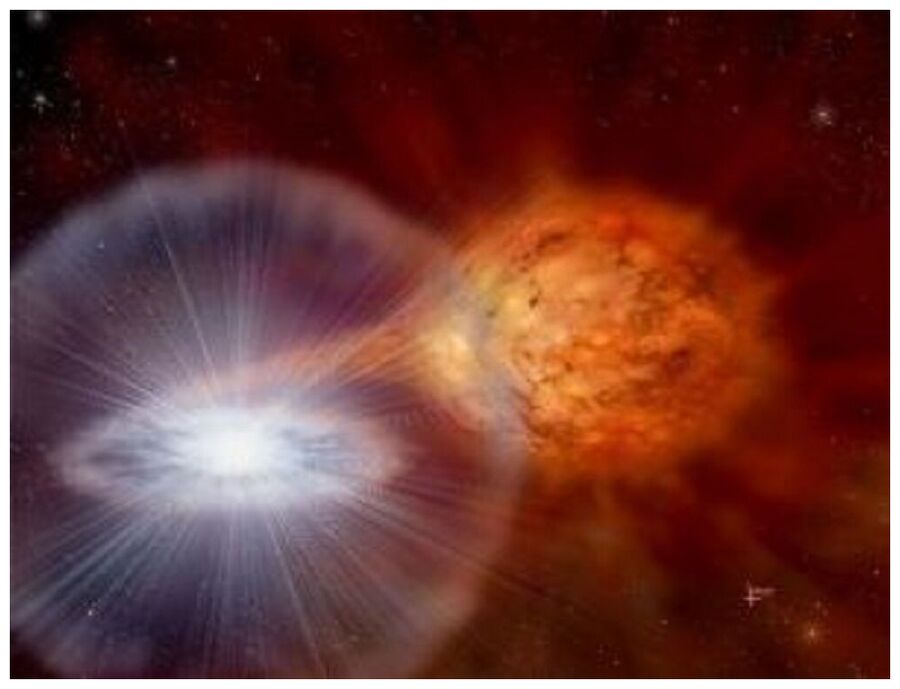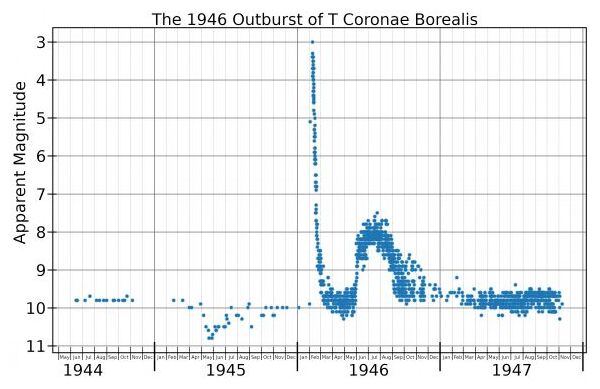
© NASAA recurrent nova in action.
If predictions are correct, a key outburst star could put on a show in early 2024.
If astronomers are correct, a familiar northern constellation could briefly take on a
different appearance in 2024, as a nova once again blazes into prominence. The star in question is
T Coronae Borealis, also referred to as the 'Blaze Star' or T CrB. Located in the corner of the constellation Corona Borealis or the Northern Crown, T CrB is generally at a quiescent +10th magnitude, barely discernible with binoculars...
but once every 60 years, the star has flared briefly into naked eye visibility at around +2nd magnitude.
The Curious Case of T Coronae BorealisThe enigma that is T Coronae Borealis was first noted by Irish astronomer John Birmingham on the night of May 12, 1866. Observers later scoured the region for decades to come, until hitting pay-dirt with a second flare-up from the star once again in 1946. None other than astronomer
Leslie Peltier of
Starlight Nights fame witnessed the 1946 outburst. A recent study by Bradley Shaefer Louisiana State University in 2023
suggests that a bright 'guest star' seen in 1217 and again in 1787 in the same region mentioned in medieval manuscripts
may in fact have been apparitions of T CrB.

© Wikimedia Commons CCA 4.0, compiled from AAVSO dataThe light curve from the 1946 outburst.
We now know that T Coronae Borealis is what's known as a
recurrent nova. This occurs when a white dwarf companion star orbiting a red giant siphons off material, which accretes and compresses around the white dwarf star. This accumulates on the white dwarf, until it reaches a limit where runaway fusion occurs, and it shines briefly as a nova.
Recurrent novae are rare, and less than 10 are known of in our galaxy.
An Outburst for 2024?This seems to suggest a periodicity of 80 years for the Blaze Star, suggesting another appearance running up to 2026. A suspicious dimming recorded in 2023, however, is now giving astronomers pause. The star behaved the same way in 1945, about a year prior to outburst. Astronomers are now hoping that we'll see T CrB brighten this year.
Located about 3,000 light-years distant, the white dwarf in the T CrB system orbits the red giant once every 228 days at just 0.54 Astronomical Units distant, inclined 67 degrees along our line of sight. Flare ups tend to happen quickly — over a span of mere hours — and last a maximum of just a day or so. Keep in mind, a change of eight magnitudes is equal to over
1,500 times in terms of brightness.
The American Association of Variable Star Observers (
AAVSO) has a long running campaign to follow T CrB, and NASA's Neil Gehrels Swift Observatory and Hubble are also on alert to follow the Blaze Star, as an outburst would provide an unprecedented opportunity to monitor such an astrophysical event in gamma-rays and across the spectrum. Hubble may also manage to catch the light echo from the event.
Finding T Coronae Borealis in the SkyThe very worst time for T CrB to pop would be in late November, when the pesky Sun sits at the same Right Ascension in the sky. Right now, Corona Borealis is well-placed for observation rising in the northeast late in the evening. T CrB is located very near +4th magnitude Epsilon Coronae Borealis and at its peak, could rival the brightest star in the constellation: +2nd magnitude Alphecca (Alpha Coronae Borealis).
If skies are clear, keep an eye on the Northern Crown in the coming months. Who knows,
you might be the first observer to spy if something is amiss in the sky.
Reader Comments
So, do all stars repeat Nova? Why would only some do this?
Would repeats explain the Ancient Amnesia? The false history? The multiple examples of catastrophe?
What we need now is the timing.
Tick Tock!